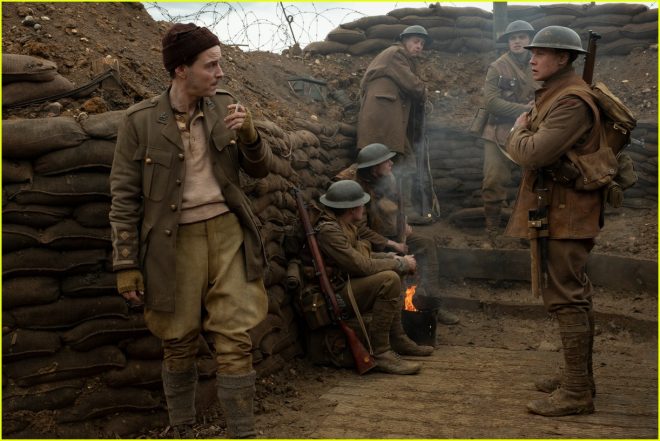
I first saw 1917 advertised on the side of a bus with the words ‘you must see this film’ emblazoned across an image of a young solider running across an active battlefield between the British and German front lines during WW1. So, inevitably, I then went to see this film. War films, a genre categorisation which has become increasingly popular over the years as technological advancements have allowed for more ‘realistic’ portrayals of the historical conflicts that have shaped our nations, are always deeply enthralling- but are they also deeply problematic? 1917 in particular, far from being simply a historical narrative informing an otherwise unempathetic audience of the events that took place that year, is an overwhelmingly impressive piece of cinema. However, the idea of its cinematographic value surpassing and even potentially overwriting its importance in representing real historical events brings into question the glamorisation war for our own entertainment purposes.
Inspired by stories from director Sam Mendes’ own grandfather, granted an expected artistic licence in adapting these anecdotes for the big screen, 1917 follows the epic journey of Lance Corporals Schofield (George MacKay) and Blake (Dean-Charles Chapman) across enemy territory to deliver a message that we as a modern audience could not possibly begin to understand the consequences of. Although the film perfectly combines more general and commonly depicted elements of war alongside the development of character and storyline, it feels there is something somewhat impersonal in these soldier’s mission. For example, it is not until the very end of the film that we see Schofield take out a picture of his wife and children, that he had kept on his person throughout the duration of the film, as if reminding us of what had been at stake the entire time. In this way, we can see how Mendes has taken what he knows of war and translated it into a plot that could have very easily been about anyone fighting on the front line at this time. This in itself could be interpreted as a undermining of the fundamentally personal aspects of the suffering experienced in war.
Having said that, both MacKay and Chapman bring these two Corporals to life in a way that could be said to bridge this gap between reality and reproduction. Their phenomenal performances, alongside a number of smaller roles given to high profile actors: including Colin Firth, Andrew Scott, Mark Strong, Benedict Cumberbatch and Richard Madden, only add to the films overall effectiveness. Scott in particular, in a role not dissimilar from his hot-priest character in hit show Fleabag, stands out as a dejected and pessimistic Lieutenant who is so sure of the missions failure that he unironically tells the Corporals- “There’s a medal in it, for sure. Nothing like a scrap of ribbon to cheer up a widow”.
Thomas Newman’s score, reminiscent of Hans Zimmer’s praised Dunkirk soundtrack, is the perfect accompaniment to the action taking place on the screen. Due to the expected inevitability of things going wrong in a film of this nature, it is impossible as an audience not to note when things are going too well and accordingly prepare ourselves for the next affliction. At points in the film, it feels as if sound is the most obvious identifier of when this moment is coming, which is no doubt adopted deliberately.
Roger Deakins is responsible for the astounding cinematography which has given 1917 much of its critical acclaim. The two hour long film is made up of 40 scenes sequenced together to make the whole thing appear as if filmed all in one shot. Not only does this give the action a more authentic quality, as we feel we are following the soldiers in real time as they race against a ticking clock, but it also means we only ever see things through the same continuous point of view as the two main characters do. In one particularly significant scene (no spoilers), the camera misses the physical act itself, and we as an audience, just as they on the screen, are left only with the aftermath. The only time-lapse we experience goes on during a 16 second black screen about half-way through the film, in which hours of on-screen time have supposedly passed before we return to the action of the camera. Everything about the film’s production and direction is perfect, if only the same could be said of the events that the film is depicting.
1917’s deeply impressive cinematography is set against a background of horrific and very real conflict, bringing into question the ethical consumption of cinematic entertainment exploiting tragedy and suffering. It also feels that the film is less about warfare than it is about cinema, Robbie Collin’s Telegraph review comparing it to a ‘video game’ because it involves ‘a series of increasingly difficult and hair-raising challenges that have to be surmounted in order, interspersed with leanly scripted encounters with various non-player characters’. This could be interpreted as a weakness or a strength of the film but, either way, is it right to use a film about real historical events that caused so much pain and destruction to brag about impressive filmmaking technique?
1917 was awarded a Golden Globe for Best Motion Picture and Best Director and Bafta for Best Film, so there is no denying its contemporary success. Whether or not you feel that the horrors of war can ever be appropriately translated to the big screen, it is impossible not to appreciate this film for the art that it is. Never before have I left a cinema feeling so moved by depictions of humanity, or lack thereof, that may or may not have happened in a certain way exactly but somehow still transcend the barriers of time and place regardless. 1917 stands out both in the genre in which it is situated but also as an overall masterpiece of modern filmmaking. So yes, you really must see this film.
Written by Esther Huntington-Whiteley



Average Rating